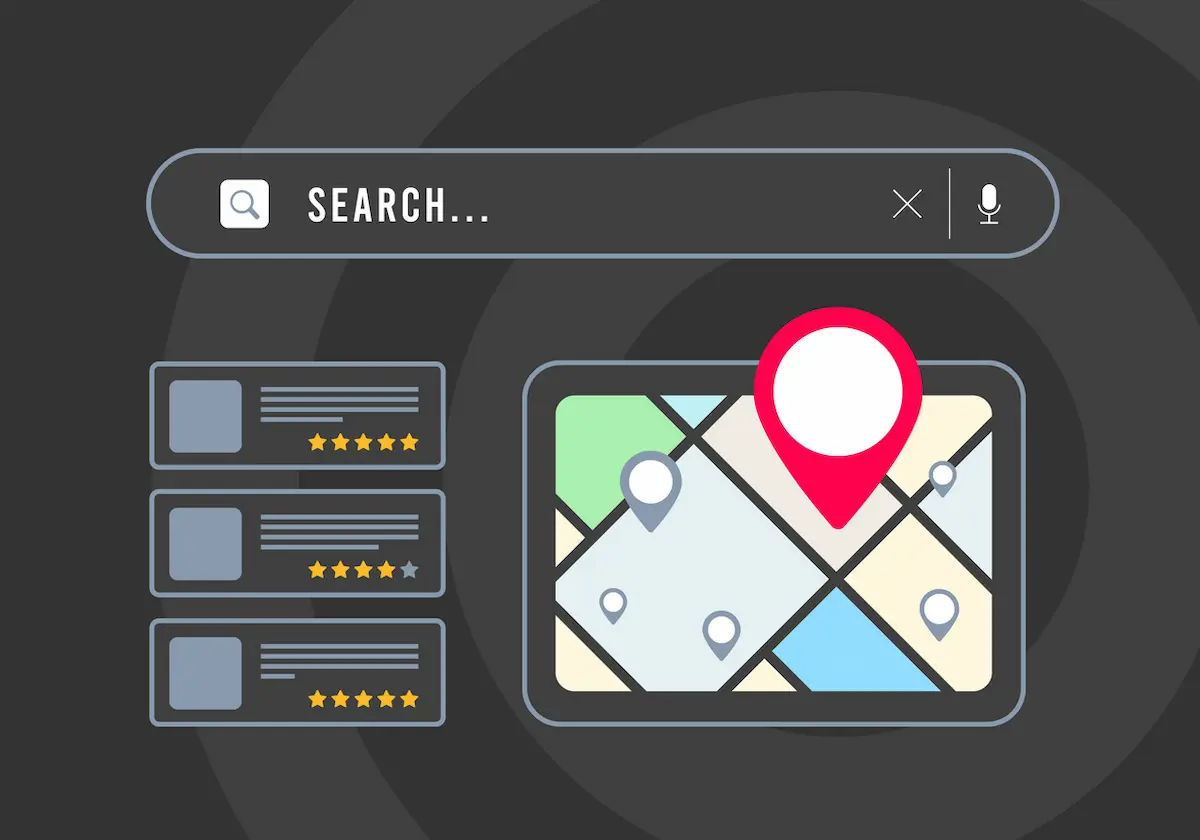Improving User Experience for Local Searches

Explore how to optimize your website to better serve local searchers and convert them into customers in today's location-driven digital marketplace. Our Google Business Profile management services and local SEO strategies help you dominate local search results.
01 Understanding Local Search Behavior
When potential customers search for local businesses, they're typically further along in the buying journey than someone making a general query. These users have specific intent and are often ready to make a purchase, book a service, or visit a physical location. Their searches commonly include location modifiers like "near me," city names, or neighborhoods. For example, when someone searches "web design El Paso," they're specifically looking for design services in that location, not general information about web design principles.
Location-based searches are the most valuable for connecting with local customers. At Keystone Web Solutions, we've seen this firsthand. For example, we rank number one in the local search pack for the high-intent term "website developer near me." This coveted position drives qualified leads directly to our business from people actively seeking our services in the area. This pattern of local search behavior repeats across countless industries and locations, highlighting just how important it is to optimize your website for these high-intent local searchers who are ready to convert.
02 Essential Elements for Improving Local Search UX
Creating an effective local search experience requires a comprehensive approach that addresses both technical optimization and user-centered design. The following strategies will help ensure your website not only ranks well for local searches but also delivers an exceptional experience that converts visitors into customers.
03 Mobile-Friendly Design is Non-Negotiable
Over 60% of local searches happen on mobile devices. Your website must prioritize mobile optimization. This isn't merely about having a responsive design—it's about creating an experience tailored specifically for on-the-go users who need information quickly and are often ready to take immediate action, or immediately leave your website if they can't find what they're looking for.
-
Fast loading times (under 3 seconds): Mobile users abandon sites that take too long to load. Compress images, use browser caching, and minimize HTTP requests to ensure your pages load instantly, even on slower connections. Our images are all in WEBP format, which is a great way to reduce loading times. We use a cache control of 1 year for our assets because most of our them are static and don't change. This is good for logos, icons, decorative images, etc. This means that the browser will cache them for a year and load in quicker on repeat visits, great for performance.
-
Easy-to-tap buttons and navigation: Design call-to-action buttons (CTA) that are at least 44x44 pixels—the recommended size for comfortable tapping—and space navigation elements adequately to prevent accidental clicks.
-
Simplified forms that are easy to complete on smaller screens: Reduce form fields to the absolute minimum, use appropriate input types (like tel for phone numbers), and enable autofill to simplify the completion process.
-
Text that's readable without zooming: Use a minimum font size of 16px for body text and ensure sufficient contrast between text and background colors to maintain readability in various lighting conditions.
04 Localized Content That Resonates
Generic content fails to connect with local audiences who are looking for businesses that understand their specific needs and community. Creating localized content shows that you're not just a faceless business—you're a part of the local ecosystem.
Local Content Strategy
Content that mentions specific neighborhoods, landmarks, and local terminology performs 3x better in local search results and creates stronger connections with community members.
-
Include neighborhood or city-specific pages with relevant information: Develop dedicated landing pages for each location you serve that include localized keywords, maps, directions, and information specific to that area. For instance, if you offer web design services in El Paso, create a dedicated page optimized for "web design El Paso" with content that speaks directly to local businesses.
-
Publish blog posts about local events or issues: Demonstrate your community involvement by covering local business events, industry meetups, or addressing challenges specific to the area. This shows that you understand the local market and positions you as a resource.
-
Feature case studies of local clients: Showcase your work with nearby businesses to build credibility with potential customers in the same area. These testimonials are powerful social proof that resonates more strongly than generic reviews.
-
Use natural language that includes geographic terms your customers use: Incorporate the specific neighborhood names, landmarks, and regional terminology that locals use when referring to their area. This subtle touch makes your content feel more relevant and authentic.
05 Clear and Accessible Contact Information
When someone finds your business through a local search, they're often ready to reach out. Any friction in this process can lead to lost opportunities. Making your contact information prominently visible and easily accessible is crucial for converting these high-intent visitors.
Poor Contact Visibility
- Contact info buried in footer
- No click-to-call functionality
- Generic contact forms
- Missing business hours
Optimized Contact Display
- Prominent header placement
- One-tap calling on mobile
- Location-specific forms
- Real-time open/closed status
06 Streamlined Local Navigation
The way users navigate your website should align with how they think about location-based services. A well-structured local navigation system helps visitors quickly find the location-specific information they need without frustration.
07 Local Schema Markup Implementation
Schema markup may be invisible to users, but it plays a crucial role in how search engines understand and display your business information. This structured data helps search engines connect the dots between your business and local search queries.
Schema Markup Benefits
Properly implemented LocalBusiness schema can increase click-through rates by up to 30% by displaying rich snippets like ratings, hours, and location directly in search results.
08 Showcasing Social Proof
Local consumers rely heavily on social proof when making decisions about nearby businesses. Building trust through various forms of verification and community connection can significantly impact conversion rates for local searchers.
09 Measuring Success in Local Search UX
Implementing these strategies is just the beginning. To truly optimize your local search user experience, you need to consistently measure performance and refine your approach based on data-driven insights.
-
Local conversion rates: Track how many local visitors take desired actions like calling your business, requesting directions, filling out contact forms, or making purchases. Segment this data by source, device, and location to identify specific optimization opportunities.
-
Bounce rates on location pages: Monitor how quickly visitors leave your location-specific pages. High bounce rates may indicate content that doesn't meet user expectations or address local needs effectively.
-
Time spent on local content: Analyze how long visitors engage with your location-specific content. Longer engagement times typically signal relevant, valuable information that resonates with local audiences.
-
Click-through rates from local search results: Measure how often your listings in local search results lead to website visits. Low CTRs might indicate issues with your meta descriptions, titles, or schema implementation.
-
Rankings for local keywords: Track your position for key location-based terms like "web design El Paso" to gauge your visibility to local searchers and identify opportunities for improvement.
10 Conclusion
Optimizing your website for local searches isn't just about appearing in search results—it's about providing a seamless experience that makes it easy for nearby customers to find you and take action. By implementing these strategies, you'll not only improve your visibility for valuable search terms like "web design El Paso" but also create a better user experience that turns local searchers into loyal customers.
Remember that local SEO is an ongoing process that requires consistent attention and updates. As search patterns and technologies evolve, continue to refine your approach to stay ahead of the competition and remain visible to your local audience. The businesses that succeed in local search are those that truly understand their community's needs and create digital experiences that address them effectively.
Ready to optimize your website for local searches?
Let's improve your local search visibility and create a website that connects with your community. Learn about our Google Business Profile optimization, local SEO services, and mobile-optimized web design.
Contact Us TodayStuff You Should Know
Statistics about how users behave when websites take too long to load highlight the critical importance of fast loading times for user retention and conversion rates. Here are some key findings from studies and surveys:
Impact on User Behavior
- User Abandonment: 53% of mobile users will abandon a website if it takes longer than 3 seconds (Google, 2021).
- 1-Second Delay: A 1-second delay in page load time can reduce conversions by 7% (Akamai, 2022).
- Bounce Rates: Websites that load within 2 seconds experience a bounce rate (percentage of visitors leaving after viewing only one page.) of 9%, while those taking 5 seconds or more see bounce rates jump to 38% (Pingdom, 2023).
- Customer Dissatisfaction: 79% of shoppers dissatisfied with website performance are less likely to buy from the same site again (Neil Patel, 2023).
Revenue and Conversions
- Revenue Loss: A 2-second delay in load time during a transaction can result in abandonment rates up to 87% (Akamai, 2022).
- eCommerce Impact: For a site making $100,000 per day, a 1-second page delay could potentially cost $2.5 million in lost sales per year (Kissmetrics, 2023).
- Conversion Rates: Pages that load in 2 seconds or less have an average conversion rate of 4.8%, compared to 2.4% for slower pages (Portent, 2022).
User Expectations
- Speed Expectations: 47% of users expect a webpage to load in 2 seconds or less (Akamai, 2022).
- Mobile vs. Desktop: Mobile users are 2x more likely than desktop users to abandon a slow-loading site (Google, 2021).
SEO and Search Rankings
- SEO Impact: Page speed is a ranking factor in Google's algorithm for desktop and mobile searches (Google, 2020).
- Visibility: Slow-loading websites are penalized in search rankings, reducing organic traffic.
Key Takeaways
Faster loading times lead to better user experience, higher conversions, and improved retention.
Modern users expect speed, efficiency, and a seamless experience, especially on mobile devices.
Investing in tools like PageSpeed Insights, lazy loading, and image optimization significantly reduces loading times.
